Oh, Here's What's Wrong...
From the instruction manual for a clock radio:
Labels: Electrical Theory, RTFM
From the instruction manual for a clock radio:
Labels: Electrical Theory, RTFM
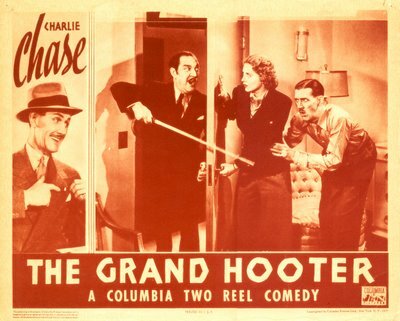
The word "hooter" used to mean "nose." Somehow its position in anatomy slipped.
Pay no attention to the "ie" at the end of Charley Chase's name in the lobby card above. His name, at the time he made "The Grand Hooter" was then, is now, and forever shall be Charley, C-h-a-r-l-e-y, as in "Charley, My Boy." Yes, even Columbia Pictures occasionally misspelled his name.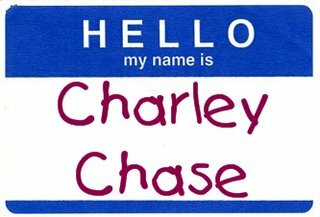 And it's Charley's good name I'm here to talk about.
And it's Charley's good name I'm here to talk about.
Lets take a step back.
What's your reaction when some despicable crime, committed by some unknown individual, galvanizes the nation?
Depending on the nature of the crime, you'll register sympathy, empathy, anger, despair, and/or incredulity. You'll ask what this country's coming to, and if it's really come to this, when something like what happened can happen. If there's a minority, religion, political party, geographic area or identifiable group you despise, you'll be tempted to assign blame ("This is how Pilates and soy milk are destroying the fabric of America.")
Personally, I skip all that stuff and focus on one thing only in a "major new crime" situation: Will the criminal, once discovered, share my name or any part of it? Because I'd surely have to change names immediately were that the case.
What do you imagine all the Lee Oswalds of the world were doing on Monday morning, November 25, 1963? Thinking up new names as they pushed people aside in their fervent effort to reach city hall.
Ironically, fear of this possibility has been nameless. Sigmund Freud had a name for it, though: nominidemophobia, from the Latin for "same name fear." The name has not been widely adopted, perhaps because this was the Sigmund Freud who played utility infield Triple A ball for the Portland Beavers in the late 1980's. Others have suggested that the inherent unpronounceability of nominidemophobia may be to blame.
Nonetheless, many of us suffer from nominidemphobia, which is the primary reason media coverage of assassins has always included the middle name. It is for the sake of all the Bruno Hauptmans with middle names other than Richard and the sake of all John Booths who are not Wilkses that middle names are a must.
You doubt that? WhitePages.com has 146 people named John Booth, including the Jons, the Johnnies, the Jonathans and the Jacks.
Not one of them - not one - has "W" as their middle initial.
While it's true that there is a general paucity of "W" middle names due to the letter's close association with our soon to be ex-president, most nominologists maintain that nearly all the "W" aversion seen in the current crop of John Booths remains powered exclusively by a single 1865 event.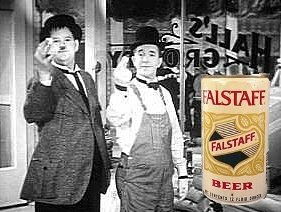 It may be true that, as Stan says to Ollie in Tit For Tat (a possible future Charley Chase film title; see below), "He who filters your good name steals trash."
It may be true that, as Stan says to Ollie in Tit For Tat (a possible future Charley Chase film title; see below), "He who filters your good name steals trash."
Shakespeare's Falstaff is the source of the original quote, "He who steals my good name, steals all that I have." (Falstaff's name was later stolen by a beer.)
And now, trash has stolen Charley Chase's good name, and you need a filter - specifically, Google's SafeSearch filter - when you perform a search on his name.
Below is a rare photo of Charley Chase without clothes, from the 1932 two-reel Hal Roach comedy In Walked Charley. This is not the reason you need SafeSearch.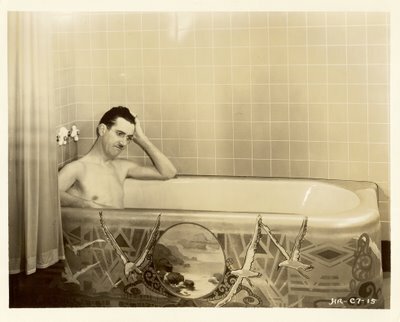
Below is a rare photo of Charley Chase with clothes, publicity from or for an unknown production. This is not the reason you need SafeSearch.
It's all the other pictures of the Charley Chase seen immediately above, 99% of which are NSFW.
Were the latest Charley Chase an actress, she'd have to join The Screen Actor's Guild, which frowns upon name-cloning:
It is the Guild’s objective that no member use a professional name which is the same as, or resembles so closely as to tend to be confused with,the name of any other member. The Guild urges all applicants and members to minimize any personal or individual risk of liability by avoiding a name that may cause confusion. (Guild Rule 15).
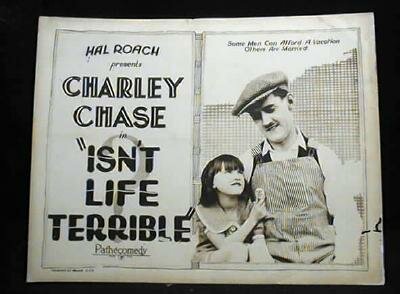
Labels: Charley Chase, Diane Keaton, George W. Bush, John Wilkes Booth, Laurel and Hardy, Michael Caine, Michael Douglas, Michael J. Fox, Michael Keaton, Screen Actors Guild, Sigmund Freud
 The Eveready Book of Radio Stars is a 60 page promotional booklet "presented with the compliments of Eveready Raytheon 4-Pillar Radio tubes, a product of National Carbon Company, a unit of Union Carbide and Carbon Corporation." Very detailed information about the sponsor - no information whatsoever about the date of publication.
The Eveready Book of Radio Stars is a 60 page promotional booklet "presented with the compliments of Eveready Raytheon 4-Pillar Radio tubes, a product of National Carbon Company, a unit of Union Carbide and Carbon Corporation." Very detailed information about the sponsor - no information whatsoever about the date of publication.
We can use Guy Lombardo as a yardstick, since he's described as "a 29 year-old orchestra leader." The perpetrator of "the sweetest music this side of heaven" was born in 1902, which makes the publication date for the brochure pretty early in radio history - 1930 or 1931. Yet the page on the Marx Brothers mentions "Flywheel, Shyster and Flywheel, Attorneys at Law," which debuted in the fall of 1932.
This can mean only one thing: Guy Lombardo lied about his age.
Whatever the date, this is definitely early radio. That's not a mirror being held by the diaphanously gowned cover girl - it's one of those old ring microphones with the spring-mounted transducer - that's so twenties.
Yet the opening pages are awash in nostalgia concerning "old time radio": Are you a veteran radio fan? Does your memory go back to the days - and nights - when the family sat around a home-made crystal set and took turns at the headphones?
Well, that certainly throws our tawdry little fights over the remote control into perspective.
The Eveready Hour was already history - off the air - by the time the Radio Stars book came out. First broadcast in 1923 by WEAF in New York City, Eveready made history in another way, when its sponsor
"...persuaded the American Telephone & Telegraph Company, then owners of WEAF, to arrange a hook-up of neighboring stations by land wire. And chain broadcasting was born!"

 The two had ambitions beyond radio, as can be seen from an April 1929 vaudeville schedule. (Parenthetically, the previously mentioned Marx Brothers were headlining at another NYC vaude house this same week.)
The two had ambitions beyond radio, as can be seen from an April 1929 vaudeville schedule. (Parenthetically, the previously mentioned Marx Brothers were headlining at another NYC vaude house this same week.) Not a terribly well kept secret, since Jane not only autographed my mom's book using her real name, Muriel Harbater, but also wrote out her address: 221 West 82nd Street. She probably didn't have time to write "Help," or "Call the Cops."
Not a terribly well kept secret, since Jane not only autographed my mom's book using her real name, Muriel Harbater, but also wrote out her address: 221 West 82nd Street. She probably didn't have time to write "Help," or "Call the Cops."JOLLY BILL AND JANE, early-morning music and song for children. Broadcast History: 1928-1938, NBC, Red and Blue Networks at various times. Many timeslots, often 15m, sometimes 25m, frequently in the 7-to-8 a.m. hour. Cream of Wheat, 1928-1931. Cast: Bill Steinke (lauded in the press for his "hearty laugh and cheerful nonsense at the ungodly hour of 7:15"), with Muriel Hartbater in the child's role of Jane. Peggy Zinke as Jane, ca. 1935.
 that brought the audience back the next day. It must have been the talk of the elementary school each morning around the chrome fountain while waiting in turn to get your slurp.
that brought the audience back the next day. It must have been the talk of the elementary school each morning around the chrome fountain while waiting in turn to get your slurp. In our next view of Jolly Bill (at right), he no longer has the serial killer look. He is seen with Jane #2, Peggy Zinke, who appears to think that what the world needs is another Baby Rose Marie.
In our next view of Jolly Bill (at right), he no longer has the serial killer look. He is seen with Jane #2, Peggy Zinke, who appears to think that what the world needs is another Baby Rose Marie. An early picture of Jolly Bill Steinke at his drawing board proves two things beyond a reasonable doubt: 1) that he lost a considerable amount of weight prior to his radio career, and 2) that, as a cartoonist, he wasn't much better than, say, you, assuming you have no talent for cartooning. Also, there's that strange Fatty Arbuckle vibe again; guilty of nothing, I'm quite sure, but tough to shake. Someone who looked like this might once have been considered "jolly," but today, the message we get is either "out of control and dangerous" or "on steroids." So how jolly was Jolly Bill?
An early picture of Jolly Bill Steinke at his drawing board proves two things beyond a reasonable doubt: 1) that he lost a considerable amount of weight prior to his radio career, and 2) that, as a cartoonist, he wasn't much better than, say, you, assuming you have no talent for cartooning. Also, there's that strange Fatty Arbuckle vibe again; guilty of nothing, I'm quite sure, but tough to shake. Someone who looked like this might once have been considered "jolly," but today, the message we get is either "out of control and dangerous" or "on steroids." So how jolly was Jolly Bill?Very few of the family letters are from Steinke’s father “Jolly Bill.” A few of his letters include drawings and are quite amusing. He writes about trying to stop drinking for health reasons and compliments Steinke on her artwork. [Mother] Alice Steinke’s letters are mostly about family issues, many dealing with Jolly Bill’s absences, drinking, and money problems, which are a constant source of concern to her.

 We lose track of Muriel Harbater after she married P. Gerard Himmel on October 27, 1940. Whether P. Gerard ever found Muriel's fabled tickle spot is unknown.
We lose track of Muriel Harbater after she married P. Gerard Himmel on October 27, 1940. Whether P. Gerard ever found Muriel's fabled tickle spot is unknown. But Muriel's spot in history, as well as Jolly Bill's, are secure.
But Muriel's spot in history, as well as Jolly Bill's, are secure.Labels: Children's radio shows, early radio, Eveready, Jolly Bill and Jane, Jolly Bill Steinke, Muriel Harbater, old time radio